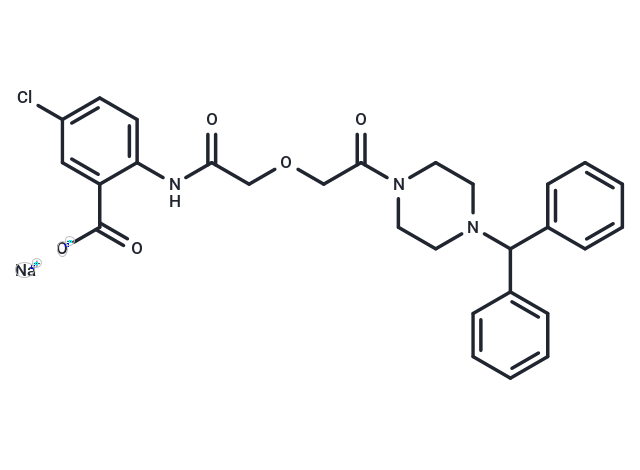Shopping Cart
- Remove All
 Your shopping cart is currently empty
Your shopping cart is currently empty

TM5275 sodium (TM5275 sodium salt) is an inhibitor of plasminogen activator inhibitor 1 (PAI-1).

| Pack Size | Price | Availability | Quantity |
|---|---|---|---|
| 2 mg | $35 | In Stock | |
| 5 mg | $59 | In Stock | |
| 10 mg | $89 | In Stock | |
| 25 mg | $172 | In Stock | |
| 50 mg | $257 | In Stock | |
| 100 mg | $371 | In Stock | |
| 200 mg | $517 | In Stock | |
| 1 mL x 10 mM (in DMSO) | $65 | In Stock |
| Description | TM5275 sodium (TM5275 sodium salt) is an inhibitor of plasminogen activator inhibitor 1 (PAI-1). |
| In vitro | 1.TM5275 inhibits formation of a complex consisting of tissue plasminogen activator (tPA), PAI-1, and GFP on vascular endothelial cells (VECs) in vitro, prolonging the time that tPA is retained on VECs. It also enhances fibrin clot dissolution and plasminogen accumulation in vitro and has antithrombotic effects in rat models of thrombosis.2.Docking studies shows that TM5275 binds to strand 4 of the A β-sheet (s4A) position of PAI-1. TM5275 is a selective PAI-1 and (up to 100?μM) does not interfere with other serpin/serine protease systems. TM5275 at concentrations of 20 and 100 μM significantly prolongs the retention of tPA-GFP on VECs by inhibiting tPA-GFP-PAI-1 high-molecular-weight complex formation. TM5275 enhances the time-dependent accumulation of plasminogen as well as the dissolution of fibrin clots on and around the tPA-GFP-expressing cells. Cell viability at 72 h treatment is decreased with 70-100 μM TM5275 in ES-2 and JHOC-9 cells. From 48 h up to 96 h, cell growth is suppressed with 100 μM TM5275. Active PAI-1 in cell culture media is significantly decreased in cells treated with 100 μM TM5275 compared to control treatment. TM5275 is suggested to exert anti-proliferative effects in ovarian cancer with high PAI-1 expression |
| In vivo | 1.TM5275 (10 and 50 mg/kg) decreases blood clot weight in an arteriovenous shunt thrombosis model and increases the time to primary occlusion in a ferric chloride-treated carotid artery thrombosis model when used at doses of 1 and 3 mg/kg. In a cynomolgus monkey model of photochemical-induced arterial thrombosis, TM5275 (10 mg/kg) increases the time to primary occlusion. It does not affect platelet activity, activated partial thromboplastin time, prothrombin time, or prolong bleeding time.2.TM5275 exhibits a favorable pharmacokinetics profile and very low toxicity to mice and rats. In rat thrombosis models. Blood clot weights are significantly lower in rats administered 10 and 50?mg/kg of TM5275 (60.9±3.0 and 56.8±2.8?mg, respectively) than in vehicle-treated rats (72.5±2.0?mg). The antithrombotic effectiveness of TM5275 (50?mg/kg) is equivalent to that of ticlopidine (500?mg/kg), a reference antithrombotic compound. Plasma concentration of TM5275 reaches 17.5±5.2?μM after a dose of 10?mg/kg. TM5275 (5?mg/kg) combined with tPA (0.3?mg/kg) significantly enhances the antithrombotic effect of tPA (0.3?mg/kg) alone and provides a benefit similar to that of a high tPA dose (3?mg/kg) |
| Kinase Assay | TM5275 exhibits a favorable pharmacokinetics profile and very low toxicity to mice and rats. In rat thrombosis models. Blood clot weights are significantly lower in rats administered 10 and 50?mg/kg of TM5275 (60.9±3.0 and 56.8±2.8?mg, respectively) than in vehicle-treated rats (72.5±2.0?mg). The antithrombotic effectiveness of TM5275 (50?mg/kg) is equivalent to that of ticlopidine (500?mg/kg), a reference antithrombotic compound. Plasma concentration of TM5275 reaches 17.5±5.2?μM after a dose of 10?mg/kg. TM5275 (5?mg/kg) combined with tPA (0.3?mg/kg) significantly enhances the antithrombotic effect of tPA (0.3?mg/kg) alone and provides a benefit similar to that of a high tPA dose (3?mg/kg). |
| Cell Research | TM5275 is prepared in DMSO.ES2 cells are treated with DMSO (control) or 100 μM TM5275 for the indicated periods (24, 48, 72, 96 hour). Cell growth is determined by CellTiter-Glo assay. |
| Animal Research | TM5275 is suspended in 0.5% carboxymethyl cellulose sodium salt (CMC).Rats: Thrombus formation in arteriovenous shunts is achieved in male CD rats. Either TM5275 (10 and 50?mg/kg, n=9) or ticlopidine (500?mg/kg, n=6), suspended in 0.5% CMC solution, is administered orally by gavage 90?mins before the study. Control rats are administered only a 0.5% CMC solution (n=10). Blood is allowed to circulate through the shunt for 30?mins. The wet weight of the thrombus covering the silk thread is eventually measured.Mice: TM5275 is administered orally by gavage to male ICR mice (50?mg/kg). Heparinized blood samples are collected from the vein before (0?h) and 1, 2, 6, and 24?h after oral drug administration. Plasma drug concentration is determined on a reverse-phase high-performance liquid chromatography |
| Alias | TM5275 sodium salt |
| Molecular Weight | 543.98 |
| Formula | C28H27ClN3NaO5 |
| Cas No. | 1103926-82-4 |
| Smiles | [Na+].[O-]C(=O)c1cc(Cl)ccc1NC(=O)COCC(=O)N1CCN(CC1)C(c1ccccc1)c1ccccc1 |
| Relative Density. | no data available |
| Storage | Powder: -20°C for 3 years | In solvent: -80°C for 1 year | Shipping with blue ice. | ||||||||||||||||||||||||||||||
| Solubility Information | DMSO: 45 mg/mL (82.72 mM), Sonication is recommended. | ||||||||||||||||||||||||||||||
Solution Preparation Table | |||||||||||||||||||||||||||||||
DMSO
| |||||||||||||||||||||||||||||||

Copyright © 2015-2025 TargetMol Chemicals Inc. All Rights Reserved.